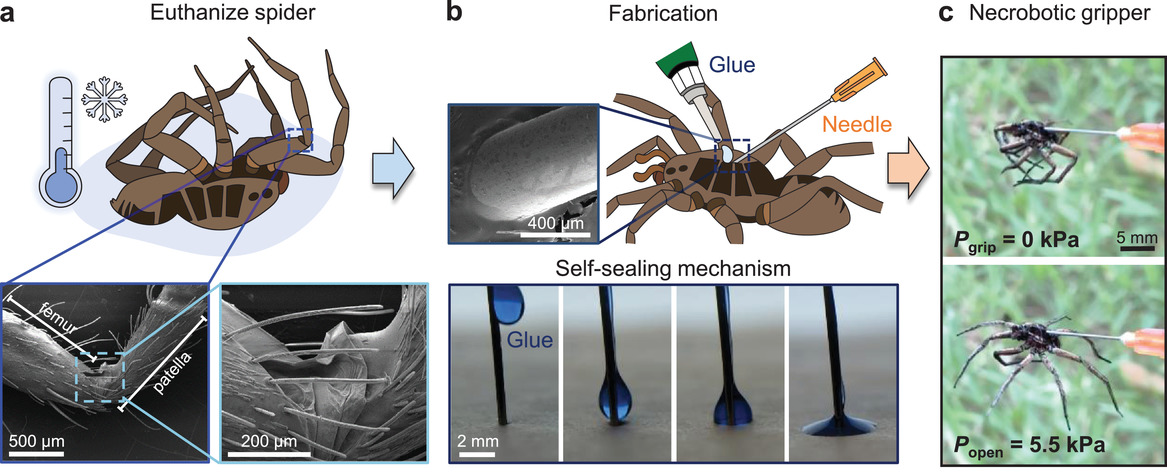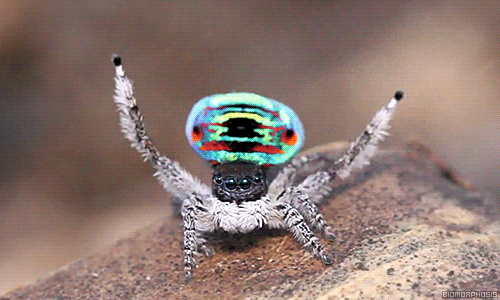Imagine a tiny robotic gripper, delicate yet powerful, capable of lifting objects many times its weight. Now, picture that this gripper is not made of metal or plastic but the reanimated legs of a dead spider. This is necrobotics, a ground-breaking field intersecting robotics and bioengineering, where deceased organisms are repurposed into functional machines.
Invention of nectrobotics
Necrobotics originated from a study at Rice University, where researchers Daniel Preston, and Te Faye Yap, manipulated a dead wolf spider’s limbs using pressurised air to force extension and contraction. This worked as a spider’s legs rely primarily on a hydraulic pressure system rather than their muscles. However, it’s worth noting a spider’s leg flexor muscles naturally constrict when relaxed meaning it takes no external power to curl their legs. To replicate the spider’s leg extension researchers inserted a syringe into the dead spider’s prosoma (head-chest region) and injected air resulting in the opening of the spider’s legs and vice versa. This process can be seen in the image below:

They tested the lifting capabilities of different species of spider necrobotic grippers and found wolf spiders could lift objects to 130% of their body weight. However, the larger the spider species, the smaller the gripping force relative to body weight.
Upon testing its lifespan functionality, researchers cyclically repeated a series of actions and found it could actuate 700 to 1000 times before cracks formed on the membrane of the leg joints due to dehydration. These degraded joints lead to loss of functionality requiring replacement.
Further description and demonstration of the system are shown in the video below:
Advantages
- Sustainability and biodegradability – as these are formed from dead biological structures they are sustainable and decompose easily.
- Fast fabrication and low cost – the time to make a spider gripper can be done in under 30 minutes. These provide an alternative to small mechanical grippers which are costly, complex and difficult to manufacture.
- Ideal for intricate tasks – necrobotic systems can grip irregularly shaped objects that are larger and heavier than itself, all while maintaining a delicate touch. One potential application is in microelectronics, where these systems could be used for simple pick-and-place actions, handling fragile components with precision.
Disadvantages
- Necrobotic systems inevitably degrade over time. The joints typically last up to 1,000 cycles, while the tissues, without preservation, begin to degrade after about a week.
- Greater chance of failure when compared to mechanical systems.
- Organic inconsistencies – not all spiders are made the same so the gripping force can vary.
- Ethical concerns surrounding necrobotics are significant. While many, find the concept intriguing, it can also feel disturbing or disrespectful to use deceased bodies for robotic purposes. As Gaurav Dhiman asks, “Does necrobotics violate the dignity and rights of deceased organisms?”
Conclusion
For better or worse, spiders hold the most potential in necrobotics. Fabricating hydraulics, muscles, and joints on such a small scale can be very challenging, if not impossible. Spiders, however, naturally possess these mechanisms, making them ideal for creating eco-friendly, biodegradable robotic systems. However, with such technology comes ethical concerns: Where do we draw the line between technology and nature? Is it ethical to manipulate once-living creatures for human use, even after death? Some may argue that using naturally deceased organisms is no different from utilizing leather or bone in craftmanship. Others may see it as a step towards commodifying life itself reducing once-living beings into mere tools.

References:
This is a good, very interesting blog about necrobotics. It explores the idea of necrobiotics which is fairly new approach in bioengineering. The blog is really well-written and its very easy to read. You could improve your blog by the addition of your self reflection, talk about your inspiration to write about the topic of necrobotics and what do you think about advantages and disadvatages of necrobotics? Is it ethical in your opinion and do you think it will have any use in the future?